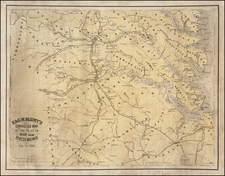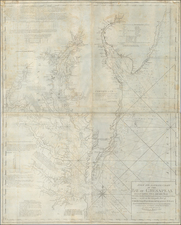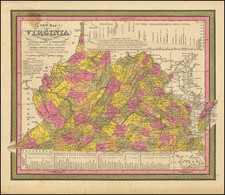With Provenance and Annotations from the Commended Leader of the 5th Virginia Infantry at Bull Run. Part of the Stonewall Brigade, and a Legendary Figure of the OId South.
Major General Kenton Harper's copy of the definitive Confederate account of the First Battle of Bull Run (First Manassas), complete with a map representing "the best in any Confederate book" (Harwell). An important work in its own right, this piece is made particularly notable with the appearance of Harper's annotations on the map showing the disposition of Jackson's Brigade at the start of the battle.
The map (lithographed by Hoyer & Ludwig in Richmond) shows the Bull Run region in exquisite battle-plan detail, with topography, forests, roads, and many other tactical features marked. Positions for twenty-three Confederate regiments, brigades, and legions are denoted, and the evolutions of their positions through the battle are shown. Federal infantry and artillery positions are also shown, and thirteen important events are marked. A cross-section of the relative heights appear in the lower left.
This printed information is supplemented by Harper's annotations of specific battle positions throughout, including his own. The advance of Kenton, Harper, Allen, and others towards Manassas Road is marked, and an "X" denotes where "Harper fell back from hill to rally our forces (?) here." Along Warrenton Turnpike, another of Harper's achievements is noted - "Harper with Elsay (?) in pursuit of the army when recalled."
The lengthy, 156-page text that accompanies the map represents an important and popular account of the battle, which defined the Southern perception of their victory. Harper's positions and orders are mentioned repeatedly in this report (where he is referred to as a Colonel, contrary to most modern sources), and at the end of the report, two blank pages are filled in with pencil annotations describing Harper's actions on the day of the battle.
This piece represents a Confederate major general's personal memento of his involvement in one of the most important Southern victories of the war.
First Manassas
The first major engagement of the Civil War, Bull Run (or Manassas as it is known in the South) was fought as the Union Army marched on Richmond. Contested only 30 miles southwest of Washington, D.C., this battle has become memorialized in countless history textbooks as the battle that both sides thought they would win easily and the battle that drew picnicking spectators from both sides.
The battle itself proved to be a Confederate victory, despite the mishandling of the engagement on both sides. This victory was mainly due to the steadfastness of the brigade of Virginians who fought under Thomas J. Jackson, which held the Confederate lines when the battle seemed destined to turn poorly. This steadfastness resulted in the renaming of the brigade as the "Stonewall Brigade," a name also bestowed on their leader. Kenton Harper reportedly had a role in the giving of this name, although we have been unable to trace primary sources that confirm this.
Kenton Harper
Born in Pennsylvania to the publisher of a local newspaper, Harper at first seemed like an unlikely candidate to join the Confederacy. However, at twenty-two, he moved to Virginia where he bought the newspaper called the Republican Farmer, which he published for twenty-four years and ingrained himself in his Appalachian foothill community. He was also involved in local politics and served as a captain of the 1st Virginia Infantry during the Mexican-American War. Following this, his political profile evidently grew rapidly and he would become an Assistant Secretary of the Interior for the federal government.
At the start of the Confederacy, given his continuing role in the Virginia state militia, he was offered command of the 5th Virginia Infantry at the age of sixty-one. He immediately raised his standing when he led the occupation of Harper's Ferry in April of 1861, where he managed to capture thousands of muskets and send them back to Richmond, despite the Union-led burning of the federal arsenal. His next, and final major engagement was at the First Battle of Bull Run, where he was repeatedly commended for his regiment's key role as part of the Stonewall Brigade that helped turn the tide of the battle in favor of the Confederacy. He would soon after surrender his position when Jackson refused him leave to visit his ailing wife.











![[Amherst County Survey of 200 Acres Owned by Captain James Dillard dated 16, 1822]](https://storage.googleapis.com/raremaps/img/small/73745.jpg)


![A New Map of Virginia [Chesapeake]](https://storage.googleapis.com/raremaps/img/small/43053.jpg)

